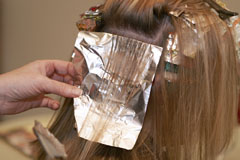Alopecia
Description:
Alopecia is essentially ‘hair loss’. It describes the partial or complete loss of hair, particularly on the scalp.
Symptoms:
Partial or complete loss of hair on the scalp, often in patches
Causes:
It is normal for a certain amount of hair loss to occur naturally, in fact we lose 50-100 hairs everyday and these can be removed by shampooing or brushing your hair. However there are a number of factors that increase the rate of hair loss. For less serious cases of alopecia, these could be relatively simple things such as:
- Stress or anxiety
- Daily repetition of hairstyles
- Prolonged tension such as wearing your hair in braids or pony tails held with tight elastic bands
- Pregnancy
- Stopping taking birth control
- Hot rollers, curlers, and hair dryers
The factors listed above normally only cause temporary hair loss as the hair follicles are not damaged and so can produce new hairs. A follicle is a pit in the scalp out of which new hairs grow. Permanent damage to the follicles will cause permanent hair loss as the follicle is unable to function and grow new hairs.
There are some much more serious medical conditions which can cause permanent hair loss otherwise known as alopecia:
 Alopecia areata is an autoimmune disease which affects women. In this case the hair follicles are attacked by white blood cells and become smaller, reducing hair production.
Alopecia areata is an autoimmune disease which affects women. In this case the hair follicles are attacked by white blood cells and become smaller, reducing hair production.
One of the most common forms in both men and women is telogen effluvium. This is wide spread shedding of hairs, causing general thinning, as a reaction to intense stress. It doesn’t develop immediately after the trigger so the exact cause can be difficult to pinpoint. This condition normally lasts around 6 months.
Sudden stress can cause large numbers of hairs to enter the telogen phase of the growth cycle. The hair cycle includes 3 phases:
- Anagen phase. This is the growing phase and last between 3 to 7 years, during this stage the follicle is deep in the scalp.
- Catagen phase. This is the resting phase and lasts about 2-4weeks, during which the follicle moves up towards the surface of the scalp.
- Telogen phase. The final stage is the shedding phase and lasts for 3-4 months. The old hair is shed and the follicle rests for a short time, moving back down into the scalp before starting the cycle again and producing a new hair. Normally only 15% of hairs are in this stage at any one time.
 In telogen effluvium a large number of hairs enter the last, shedding phase, and after 3months they are all quickly shed which means that the hair becomes very thin. Because the telogen phase takes 3 months before the hairs are actually lost it takes a while before you are aware of the problem which makes the trigger more difficult to identify. However this condition can get better with time and is not permanent.
In telogen effluvium a large number of hairs enter the last, shedding phase, and after 3months they are all quickly shed which means that the hair becomes very thin. Because the telogen phase takes 3 months before the hairs are actually lost it takes a while before you are aware of the problem which makes the trigger more difficult to identify. However this condition can get better with time and is not permanent.
Another condition is androgenetic alopecia which is related to hormone levels, but in most cases there is a genetic predisposition as well. In this case the hair loss is caused by a chemical called dihydrotestosterone (DHT) which is made from male hormones, androgens, which we all have. Androgens are made by the action of the enzyme 5-alpha reductase. If you have excess DHT then the hair follicles make thinner and thinner hairs until they eventually stop completely.
Permanent damage to the follicles will cause permanent hair loss as the follicle is unable to function and grow new hairs. This can be caused by:
- Serious scalp burns
- Excessive exposure to X-rays
- Viral infections
- Hereditary factors
- Side effects of some drugs
- Recent surgery
- Illness or fevers
- Heavy metal poisoning such as arsenic
- Malnutrition especially if you are deprived of iron and protein
Treatments:
If you think that you are suffering from one of the less serious and temporary forms of alopecia, there are a few solutions you could try:
- Use products that tone and invigorate the scalp to stimulate growth.
- Do scalp massages to reduce stress levels, loosen and stimulate the scalp to promote growth.
- Make lifestyle changes. For example, if you believe you are losing hair through stress, locate the cause of this anxiety and do as much as possible to remove it. This can naturally be difficult but is most surely the best method of halting alopecia.
- Change hairstyles regularly.
- Tie up your hair more loosely.
If you are unsure and worried about hair loss, it is recommended you contact your GP.
There is no solution to permanent hair loss. Wigs and hair-pieces can hide the affects but of there is permanent damage to the follicles then the hair cannot re-grow.
If you have suffered either temporary or permanent alopecia due to chemical or heat burns at your hair salon, you could be entitled to compensation for hairdresser negligence. Suffering from alopecia can cause great embarrassment and many difficulties in your day-to-day life. The costs of these humiliations, as well as any subsequent hair treatment needed to deal with the problem of hair loss, can be claimed in compensation.
At Macks Solicitors, we have specialist lawyers able to deal with any legal enquiries you have that relate to hair negligence. To receive expert advice and help for your situation call Free phone 0800 980 9389 or 01642 252828. Alternatively, visit our website at www.mackssolicitors.co.uk and complete the online claim form. We will be happy to give you no-obligation expert advice on the possibilities of your making a claim and of how the process works. We are very proud of our quality caring service and that our customers generally come to us through recommendation. Making a compensation claim for your extra expenses, physical and psychological injuries can help get your life back to normality. Alopecia is a upsetting experience and you should not have to deal with it alone.

























